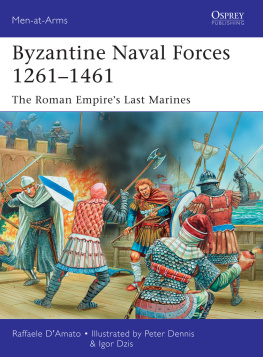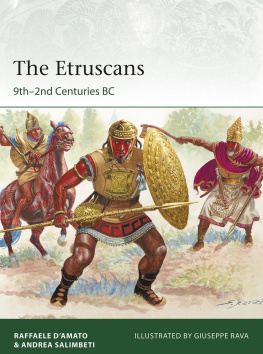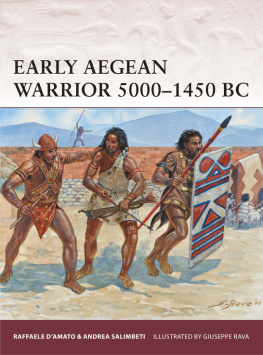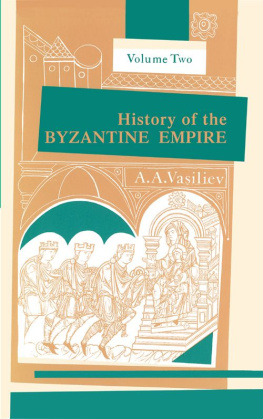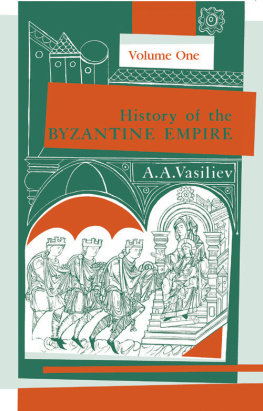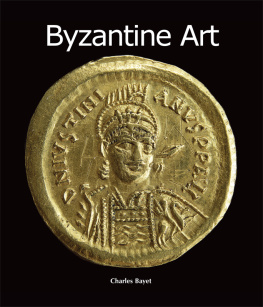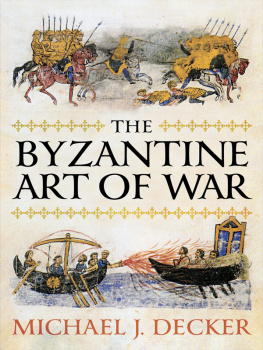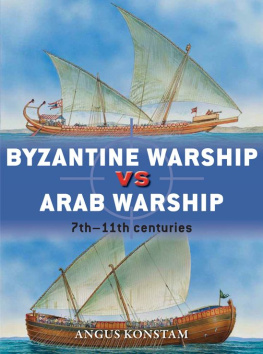
Dedication
To my beloved sons Michail and Flavius Victor, hope of all my life
DR RAFFAELE DAMATO is an experienced Turin-based researcher of the ancient and medieval military world. After achieving his first PhD in Romano-Byzantine law, and having collaborated with the University of Athens, he gained a second doctorate in Roman military archaeology. He currently works as vicehead of the Laboratorio delle antiche Provinche Danubiane at Ferrara University, under Prof Livio Zerbini. Dr DAmato has written and co-authored a number of books for Osprey on Ancient and Early Medieval subjects.
PETER DENNIS was born in 1950. Inspired by contemporary magazines such as Look and Learn he studied illustration at Liverpool Art College. Peter has since contributed to hundreds of books, predominantly on historical subjects, including many Osprey titles. A keen wargamer and modelmaker, he is based in Nottinghamshire, UK.
IGOR AKSENT JEVICH DZIS was born in 1968 in Ukraine, and studied both at Simferopol Art College in Crimea and as a costume designer at the University of Cinematography in Moscow. He has worked on several historical films, and since 1992 has been illustrating military historical subjects for Russian and international magazines and publishing houses. He currently lives and works in Crimea. This is his first book for Osprey.
Authors Note: Byzantine and Roman
The adjective Byzantine is a modern creation. Though their language was Greek, and Westerners called them Greeks, the inhabitants of the Eastern Roman Empire called themselves, with full right, Rhomaioi, i.e. Romans. The polity of Byzantium was an uninterrupted survival of the Late Roman Empire after the fall of the West in AD 476, and it represented the political and cultural evolution of the Roman state. In this text the term Byzantines refers only to the people of the capital of that empire, Constantinople or Byzantium, since in the period discussed they were indeed called Vyzantioi; but the soldiers and sailors who served the Empire are given their dignity as Romans.
Note on spelling: Since this text draws upon ancient, historical and modern sources in several languages, including Latin and Greek, the spelling of some names is unavoidably inconsistent.
Acknowledgements
For a great deal of new historical material in this text my thanks are due to my dear friends Prof Taxiarchis Kolias, Director of the Institute for Byzantine Research at the University of Athens, and Dr Andrea Babuin of the University of Ioannina.
For making it possible for me to photograph the frescoes from Geraki and the Mani peninsula, published here for the first time in colour, I express my gratitude to the 5th Ephorate of Greece, responsible for the regions of Lakonia and Mani. In particular I would like to thank Dr Evanghelia Pantou, director of the Ephorate, and Dr Georgios Mitris of the local archaeological museum in Aeropolis, who joined me under the hot sun in my search for the most hidden churches of the Mani region.
Thanks for access to Bulgarian finds are due to Prof Valeri Yotov of the University of Varna, and to Dr Stanimir Dimitrov. I am also indebted to Prof Ewald Kislinger of the Institut fr Byzantinistik und Neogrzistik, University of Vienna, who put the library at my disposal. Dr David Nicolle generously furnished me with some of his photographs. Thanks are due to the Biblioteca Riccardiana in Florence, and in particular to Dr Rossella Giovannetti. I must also thank Mr Haluk Perk of Istanbul, for the doors he opened and for kind permission to publish previously unknown items.
Further acknowledgements are due to: the Archaeological Museum of Kazanlik, Bulgaria; the National Museum of Bulgaria, Sofia; the District Archaeological Museum in Paphos, Cyprus; the Istituto Ellenico di San Giorgio dei Greci, Venice; the National Museum of Athens; and Time-Line Auctions.
My collaborators on this book have been Drs Massimo Bizzarri, Marco Lucchetti and Andrey Negin, and Ing Andrea Salimbeti, whom I thank for their patient advice and help in the search for new finds and photos and in the preparatory drawings for the colour plates. Finally, special acknowledgement goes to Igor Dzis, and particularly to Peter Dennis, who so painstakingly carried out my instructions to provide the splendid colour plates that bring to life the last Marines of the Roman Empire in their magnificent equipment.
Artists Note
Readers may care to note that the original paintings from which colour plates B, E, F, G and H in this book were prepared are available for private sale. All reproduction copyright whatsoever is retained by the Publishers. All enquiries should be addressed to:
Peter Dennis, Fieldhead, The Park, Mansfield, Nottinghamshire NG18 2AT, UK
The Publishers regret that they can enter into no correspondence upon this matter.
TITLE PAGE
Joshua of Navi before the Archangel Michael, an image dating from 126090. The helmet appears to be of spangenhelm construction. Below a throat-guard, the contrasting-coloured body armour appears to be of scales, with padded fabric covering the torso, and double rows of protective strips resembling the pteryges of the Classical past at the upper arms and covering the groin and thighs. (Detail from fresco, in situ Church of the Taxiarchon, Geraki, Lakonia; authors photo)

First published in Great Britain in 2016 by Osprey Publishing
PO Box 883, Oxford, OX1 9PL, UK
1385 Broadway, 5th Floor, New York, NY 10018, USA
E-mail:
Osprey Publishing, part of Bloomsbury Publishing Plc
This electronic edition published in 2016 by Bloomsbury Publishing Plc
Bloomsbury is a registered trademark of Bloomsbury Publishing Plc
2016 Osprey Publishing Ltd.
All rights reserved
You may not copy, distribute, transmit, reproduce or otherwise make available this publication (or any part of it) in any form, or by any means (including without limitation electronic, digital, optical, mechanical, photocopying, printing, recording or otherwise), without the prior written permission of the publisher. Any person who does any unauthorised act in relation to this publication may be liable to criminal prosecution and civil claims for damages.
A CIP catalogue record for this book is available from the British Library
ISBN: 978-1-4728-0728-1 (HB)
ISBN: 978-1-4728-0729-8 (ePDF)
ISBN: 978-1-4728-0730-4 (eBook)
Osprey Publishing supports the Woodland Trust, the UKs leading woodland conservation charity. Between 2014 and 2018 our donations will be spent on their Centenary Woods project in the UK.
www.ospreypublishing.com
To find out more about our authors and books visit www.ospreypublishing.com. Here you will find our full range of publications, as well as exclusive online content, details of forthcoming events and the option to sign up for our newsletters. You can also sign up for Osprey membership, which entitles you to a discount on purchases made through the Osprey site and access to our extensive online image archive.
INTRODUCTION
The last two centuries of the Byzantine Empire were characterized by the continuous efforts of the central authority hampered by chaotic civil wars, and the centrifugal tendencies of the last Roman elites to organize and maintain their military resources to face the constant menace of Latins (Franks and Italians), Serbs, Bulgars, and (finally, and most dangerously) the Ottoman Turks.
Next page
